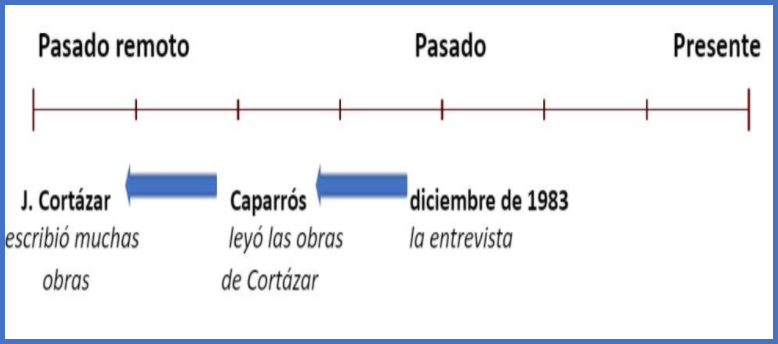6.7: El pluscuamperfecto
- Page ID
- 209739
\( \newcommand{\vecs}[1]{\overset { \scriptstyle \rightharpoonup} {\mathbf{#1}} } \)
\( \newcommand{\vecd}[1]{\overset{-\!-\!\rightharpoonup}{\vphantom{a}\smash {#1}}} \)
\( \newcommand{\id}{\mathrm{id}}\) \( \newcommand{\Span}{\mathrm{span}}\)
( \newcommand{\kernel}{\mathrm{null}\,}\) \( \newcommand{\range}{\mathrm{range}\,}\)
\( \newcommand{\RealPart}{\mathrm{Re}}\) \( \newcommand{\ImaginaryPart}{\mathrm{Im}}\)
\( \newcommand{\Argument}{\mathrm{Arg}}\) \( \newcommand{\norm}[1]{\| #1 \|}\)
\( \newcommand{\inner}[2]{\langle #1, #2 \rangle}\)
\( \newcommand{\Span}{\mathrm{span}}\)
\( \newcommand{\id}{\mathrm{id}}\)
\( \newcommand{\Span}{\mathrm{span}}\)
\( \newcommand{\kernel}{\mathrm{null}\,}\)
\( \newcommand{\range}{\mathrm{range}\,}\)
\( \newcommand{\RealPart}{\mathrm{Re}}\)
\( \newcommand{\ImaginaryPart}{\mathrm{Im}}\)
\( \newcommand{\Argument}{\mathrm{Arg}}\)
\( \newcommand{\norm}[1]{\| #1 \|}\)
\( \newcommand{\inner}[2]{\langle #1, #2 \rangle}\)
\( \newcommand{\Span}{\mathrm{span}}\) \( \newcommand{\AA}{\unicode[.8,0]{x212B}}\)
\( \newcommand{\vectorA}[1]{\vec{#1}} % arrow\)
\( \newcommand{\vectorAt}[1]{\vec{\text{#1}}} % arrow\)
\( \newcommand{\vectorB}[1]{\overset { \scriptstyle \rightharpoonup} {\mathbf{#1}} } \)
\( \newcommand{\vectorC}[1]{\textbf{#1}} \)
\( \newcommand{\vectorD}[1]{\overrightarrow{#1}} \)
\( \newcommand{\vectorDt}[1]{\overrightarrow{\text{#1}}} \)
\( \newcommand{\vectE}[1]{\overset{-\!-\!\rightharpoonup}{\vphantom{a}\smash{\mathbf {#1}}}} \)
\( \newcommand{\vecs}[1]{\overset { \scriptstyle \rightharpoonup} {\mathbf{#1}} } \)
\( \newcommand{\vecd}[1]{\overset{-\!-\!\rightharpoonup}{\vphantom{a}\smash {#1}}} \)
Ejemplos del pluscuamperfecto del indicativo: Lectura
Note that verbs conjugated in the pluperfect indicative are in bold in the following article.
Julio Cortázar, último round

Se dice que fue la última entrevista de Julio Cortázar por Martín Caparrós, periodista y novelista.
Cortázar vivía exiliado en París y visitó Buenos Aires para despedirse de su madre en 1983. Unos meses después, Cortázar falleció.
En Buenos Aires, Cortázar le contó a Caparrós que había llegado un día antes para despedirse de su madre. Caparrós quería entrevistarlo y le preguntó si era posible. Cortázar le respondió afirmativamente, pero que tenía que ser en ese momento, así que el periodista, desesperado, tuvo que inventar una entrevista que no había preparado —y se notó—. Le preguntó por algo que siempre le había intrigado: ¿por qué se le ocurrió escribir que Johnny Carter, un protagonista, había muerto de una sobredosis de marihuana?
Después de entrevistarlo por dos horas, Caparrós se encerró a transcribir la entrevista y empezó a sonar el teléfono. La noticia de su entrevista —no había otras— ya había circulado y lo llamaron de varios medios para comprársela. Sin embargo, Caparrós se la había prometido a su jefe.
Al día siguiente, un secretario de redacción se la pagó diez veces menos que lo que su jefe le había autorizado.
La noticia de su muerte llegó desde París dos meses después, el 12 de febrero; solo entonces Caparrós entendió por qué había venido a despedirse de su madre.
Si desea leer más sobre la entrevista con Cortázar, vaya al artículo.
Usos del pluscuamperfecto del indicativo
As covered in the previous chapter, the present tense of the verb "haber" can be combined with the past participle of other verbs to talk about what someone has done before the present moment. In the same way, the imperfect conjugation of "haber" together with the past participle of other verbs can be used to talk about actions and events that had happened before some other moment in the past, as in the examples below:
Ejemplo:
Here are three chronological events implied by the reading above:
-
A long time ago: Cortázar escribió muchas obras.
- Sometime after that: Caparrós leyó las obras de Cortázar.
- December, 1983: Caparrós entrevistó a Cortázar.

We can, of course, talk about each of these events separately using the preterit, as in the list above. However, if we want to explain that both the first and second events above had happened before and set the scene for event 3, we would use the pluperfect indicative:
Antes de la entrevista en diciembre de 1983, Cortázar ya había escrito muchas obras y Caparrós las había leído.
Before the interview in December of 1983, Cortázar had already written many works and Caparrós had read them.
OJO
Because the pluperfect is used to express an action that took place before some other action or moment in the past, it is frequently used alongside expressions such as ya (already), antes (before), nunca (never), todavía (still), and después (after) to emphasize that one action occurred before the other in the past.
Formación del pluscuamperfecto del indicativo
Just like the present perfect, the pluperfect is a compound tense, which just means that you will combine two verb forms:
Haber + Past participle (participio pasado)
(1) The first verb, haber, is conjugated in the imperfect tense, and you can see that below.
Congugation of Haber in the Imperfect
| yo había | nosotros/as. habíamos |
|
tú habías |
|
| él/ella/Ud. había | ellos/ellas/Uds. habían |
| *For more information on the regional forms "vos" and "vosotros", click the images above | |
(2) The second verb appears as a past participle. You can review the formation of the past participle in the previous chapter.
OJO
Unlike in English, no words can come between the form of "haber" and the past participle. When using direct, indirect, or reflexive pronouns, they must be placed before "haber". (Example: "Antes de 2017, yo todavía no me había mudado a Lancaster." / "Before 2017, I had not yet moved to Lancaster.")
En resumen
Clicking on the images below will bring you to videos that review the forms and functions and give more examples of the pluperfect indicative.
| Videolección: Formas | Videolección: Funciones | Videolección: Ejemplos |
 |
 |
 |
¡A practicar!
Actividad 1
Paso 1. Escribe una lista de 3 cosas interesantes que ya habías hecho antes de comenzar los estudios universitarios.
Paso 2. Entrevista a los compañerxs de clase. ¿Hay otras personas que también las habían hecho antes de la universidad? ¿Hay gente que no las había hecho antes pero que las ha hecho después de comenzar los estudios universitarios? ¿Hay alguien que todavía no las ha hecho?
Actividad 2
Piensa en el logro más significativo de tu vida. ¿Qué habías hecho (o no habías hecho) antes de ese momento para prepararte o para conseguir la meta? ¿Que habían hecho otras personas para apoyarte?
This page partially adapted from 8.2 Pluscuamperfecto del indicativo by Nancy Ballesteros, Alejandro Lee, Nicolás Cristoso, & Cristina Moon through ASCCC Open Educational Resources Initiative, licensed under CC BY-NC-SA, and from El pluscuamperfecto (el pasado perfecto) by Acceso, licensed under CC BY-NC 4.0.



